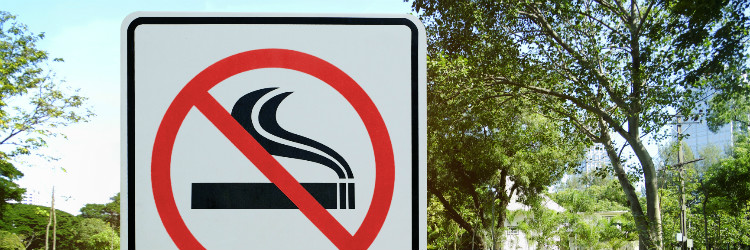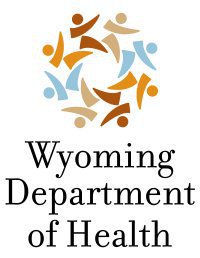Goal Area 2: Eliminating Nonsmokers’ Exposure to Secondhand Smoke
The Wyoming TPCP and the CDC share the goal of reducing the health burdens of tobacco use by eliminating nonsmokers’ exposure to secondhand smoke.
Support for Indoor Smokefree Policies and Laws
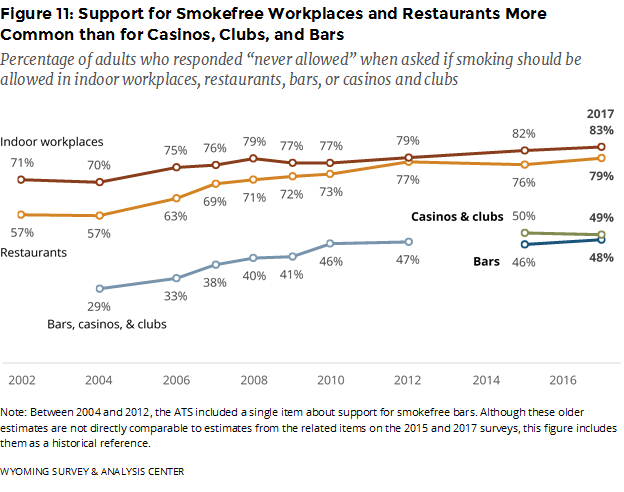 The 2017 ATS asked questions about both smokefree indoor air policies and smokefree indoor air laws. The policy questions asked respondents if they think smoking should be allowed indoors at workplaces, restaurants, bars, and casinos/clubs. (Casinos and clubs were asked as a single survey item, so WYSAC treated them as a single venue type.) The survey questions about smokefree laws asked respondents if they support or oppose statewide smokefree indoor air laws in Wyoming for the same venues.
The 2017 ATS asked questions about both smokefree indoor air policies and smokefree indoor air laws. The policy questions asked respondents if they think smoking should be allowed indoors at workplaces, restaurants, bars, and casinos/clubs. (Casinos and clubs were asked as a single survey item, so WYSAC treated them as a single venue type.) The survey questions about smokefree laws asked respondents if they support or oppose statewide smokefree indoor air laws in Wyoming for the same venues.
Results from the policy questions revealed that the percentage of Wyomingites who agreed that smoking indoors should never be allowed in workplaces or restaurants significantly increased from when comparable questions were first asked in 2002 to 2017. For bars and for casinos/clubs, support for smokefree policies remained relatively stable between 2015, when the comparable questions were first asked, and 2017, and remained lower than support for the other venues. The trend for related questions asked between 2004 and 2012 showed increasing support for smokefree indoor air in these venues (Figure 11).
In 2017, the majority of adults supported statewide smokefree indoor air laws covering all workplaces, restaurants, or casinos and clubs. About half (50%) supported a statewide smokefree indoor air law covering all bars (Figure 12). These results are not significantly different from when comparable questions were first asked in 2015.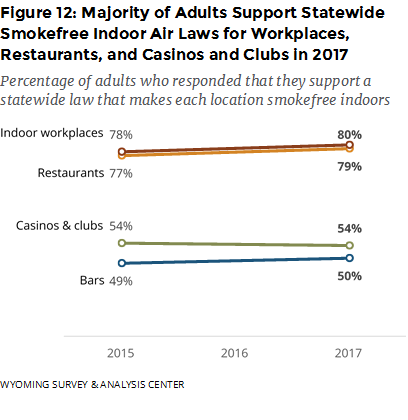
WYSAC performed logistic regression analyses to identify associations between support for a state smokefree indoor air law for each venue and seven demographic variables: age, gender, annual household income, education, race, ethnicity, and sexual orientation. WYSAC modeled each of the four venues in Figure 12 separately, using these seven demographic variables as predictors. When controlling for the other demographic variables, gender, education, and sexual orientation were significantly associated with support for legally protected smokefree indoor air for workplaces, restaurants, bars, and casinos/clubs. Men were less likely to support smokefree indoor air laws than women. Adults with an associate’s degree or less education were less likely to support smokefree indoor air laws than those with more education. Lesbian, gay, bisexual, and transgender (LGBT) individuals were less likely to support smokefree indoor air laws than straight individuals (Table 3). See Appendix C for detailed results.
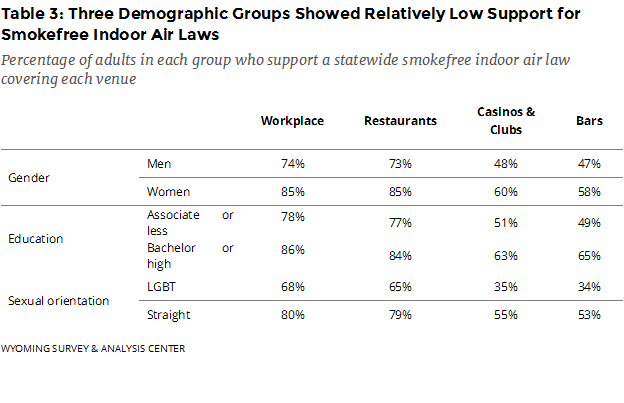
Support for Other Smokefree Air Policies and Laws
Most Wyomingites (81%) thought that smoking should be restricted at outdoor parks at least in some manner. This proportion has significantly increased from 76% in 2010. Complete restrictions are less popular than partial restrictions. In 2017, 37% of adults thought that smoking should never be allowed, and 44% of adults thought that smoking should be allowed only at some times or in some places.
Support for laws making outdoor workplaces smokefree was substantially lower than support for laws making indoor workplaces smokefree: 66% of adults opposed a state smokefree air law for all outdoor workplaces while 27% would support such a law; 7% said they were unsure. The level of support for such a law in 2017 is not significantly different from when comparable questions were first asked in 2015.
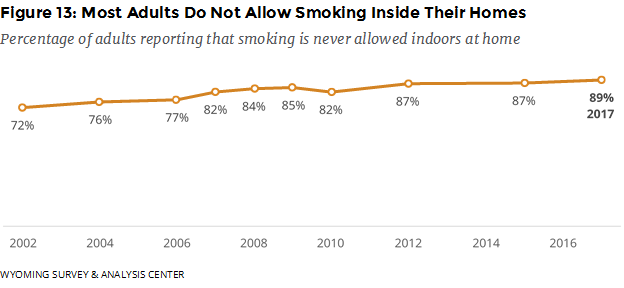 The percentage of adults who reported they do not allow smoking inside their homes has been high and has increased significantly from 72% in 2002, when the question was first asked, to 89% in 2017 (Figure 13).
The percentage of adults who reported they do not allow smoking inside their homes has been high and has increased significantly from 72% in 2002, when the question was first asked, to 89% in 2017 (Figure 13).
Exposure to Secondhand Smoke
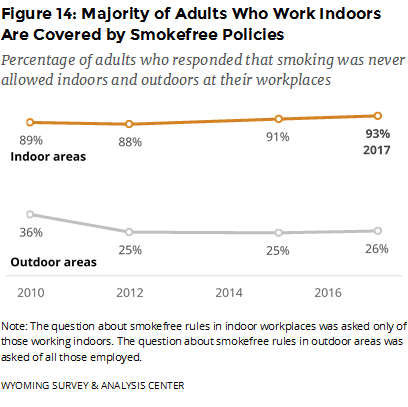 Most adults (93%) who worked indoors reported that smoking was never allowed in indoor areas (including inside a vehicle) at their place of work (Figure 14). This is a relatively small but significant increase from 89% in 2010, when comparable questions were first asked. Conversely, relatively few (26%; including those who primarily worked outside) reported that smoking was not allowed in outdoor areas. This pattern has been consistent since 2012 after a drop from 36% in 2010, when comparable questions were first asked.
Most adults (93%) who worked indoors reported that smoking was never allowed in indoor areas (including inside a vehicle) at their place of work (Figure 14). This is a relatively small but significant increase from 89% in 2010, when comparable questions were first asked. Conversely, relatively few (26%; including those who primarily worked outside) reported that smoking was not allowed in outdoor areas. This pattern has been consistent since 2012 after a drop from 36% in 2010, when comparable questions were first asked.
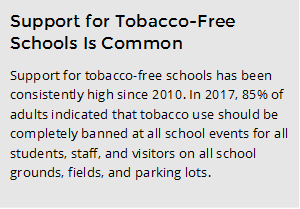 Consistently since 2010, most employed adults were not regularly exposed to secondhand smoke (SHS) at their workplace either indoors or outdoors. In 2017, 20% of working adults reported that they had breathed someone else’s smoke at their workplace in the past seven days. Adults who worked outdoors most of the time were more likely to be exposed to SHS than those who worked indoors (including in vehicles): 28% of adults who work primarily outdoors experienced SHS exposure, compared to 16% of those who work primarily indoors.
Consistently since 2010, most employed adults were not regularly exposed to secondhand smoke (SHS) at their workplace either indoors or outdoors. In 2017, 20% of working adults reported that they had breathed someone else’s smoke at their workplace in the past seven days. Adults who worked outdoors most of the time were more likely to be exposed to SHS than those who worked indoors (including in vehicles): 28% of adults who work primarily outdoors experienced SHS exposure, compared to 16% of those who work primarily indoors.
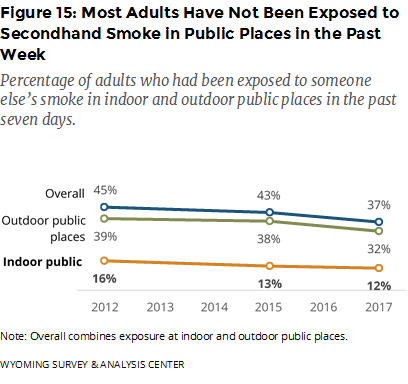 Relatively few adults reported being exposed to SHS while at indoor or outdoor public places in the past seven days (Figure 15). At both types of public places, significantly fewer adults have been exposed to SHS since 2012, when comparable questions were first asked. Also, smokers are more likely to be exposed to SHS at public places than non-smokers: 47% of smokers reported exposure to SHS while 35% of non-smokers reported exposure to SHS in 2017.
Relatively few adults reported being exposed to SHS while at indoor or outdoor public places in the past seven days (Figure 15). At both types of public places, significantly fewer adults have been exposed to SHS since 2012, when comparable questions were first asked. Also, smokers are more likely to be exposed to SHS at public places than non-smokers: 47% of smokers reported exposure to SHS while 35% of non-smokers reported exposure to SHS in 2017.
Conclusions
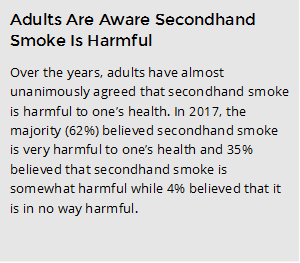
Adults almost unanimously agree that SHS is harmful to one’s health. However, opinions vary as to where and how smoking should be restricted. Adults have a high degree of support for the idea that indoor areas of restaurants and workplaces across the state should have smokefree indoor air. Similarly, support for smokefree indoor air laws covering those venues is common. Also, support for tobacco-free schools is high. There is less support for the idea that casinos, clubs, bars, and outdoor work areas should be smokefree or that there should be a law making them smokefree. As a reference point from a different survey in 2014, 71% of registered voters in Wyoming said they would support a smokefree indoor air law making all public buildings, such as government offices, stores, bars, and restaurants, smokefree indoors (WYSAC, 2015). Because that question was very different from the questions for the 2017 ATS, the difference in the estimates does not necessarily show a trend in support for smokefree air.
Most adults report working in places that have smokefree indoor air policies, but outdoor smokefree air policies at workplaces are relatively rare. Exposure to secondhand smoke is more likely to occur in outdoor areas, including at work and public places, than at indoor areas.
